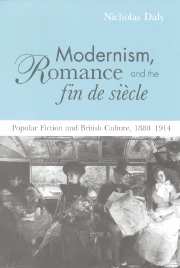Book contents
- Frontmatter
- Contents
- Acknowledgements
- Introduction
- 1 Incorporated bodies: Dracula and professionalism
- 2 The imperial treasure hunt: The Snake's Pass and the limits of romance
- 3 ‘Mummie is become merchandise’: the mummy story as commodity theory
- 4 Across the great divide: modernism, popular fiction and the primitive
- Afterword: the long goodbye
- Notes
- Index
3 - ‘Mummie is become merchandise’: the mummy story as commodity theory
Published online by Cambridge University Press: 23 November 2009
- Frontmatter
- Contents
- Acknowledgements
- Introduction
- 1 Incorporated bodies: Dracula and professionalism
- 2 The imperial treasure hunt: The Snake's Pass and the limits of romance
- 3 ‘Mummie is become merchandise’: the mummy story as commodity theory
- 4 Across the great divide: modernism, popular fiction and the primitive
- Afterword: the long goodbye
- Notes
- Index
Summary
Mummie is become Merchandise, Mizraim cures wounds, and Pharaoh is sold for Balsoms.
Sir Thomas Browne, Urne BurialIn his Travels, the English merchant-traveller John Sanderson describes a visit to the mummy-pits outside Cairo in 1586:
The Momia, which is some five or six miles beyound, ar thowsands of imbalmed bodies, which weare buried thousands of years past in a sandie cave, at which ther seemeth to have bine citie in tim[e]s past. We were lett doune by ropes as into a well, with wax candles burninge in our hands, and so waulked uppon the bodies of all sorts and sised [read sizes], great and smaule, and some imbalmed in little earthen potts, which never had forme; thes ar sett at the feet of the great bodies. They gave no noysome smell at all, but ar like pitch, beinge broken; for I broke of[f] all parts of the bodies to see howe the flesh was turned to drugge, and brought home divers heads, hands, arms, and feet for a shewe. We bought allso 600 lb. for the Turkie company in peces, and brought into Ingland in the Hercules, together with a whole bodie. They ar lapped in 100 doble of cloth, which rotton [rotting?] and pillinge of[f], you may see the skinne, flesh, fingers, and nayles firme, onelie altered blacke. One little hand I brought into Ingland to shewe, and presented it my brother, who gave the same to a doctor in Oxford.
- Type
- Chapter
- Information
- Modernism, Romance and the Fin de SièclePopular Fiction and British Culture, pp. 84 - 116Publisher: Cambridge University PressPrint publication year: 2000

